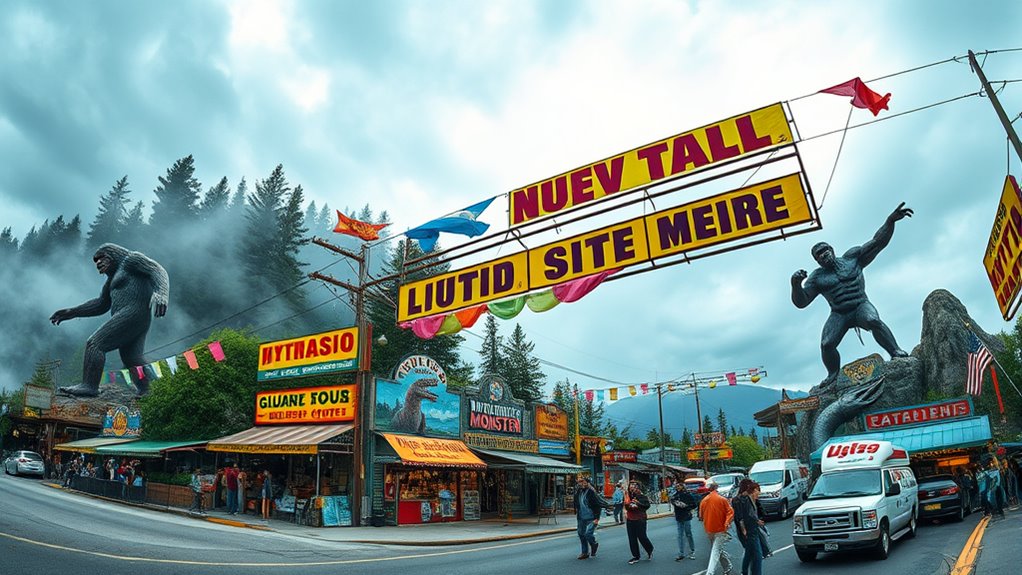Cryptid tourism turns local legends into thriving economies by attracting enthusiasts to remote areas with festivals, themed attractions, and guided expeditions. Visitors support small businesses by buying souvenirs, enjoying local accommodations, and participating in events that celebrate myths like Bigfoot or the Loch Ness Monster. These activities boost community pride and create jobs, ensuring the legends stay alive while fueling economic growth. If you want to explore how myths transform into economic powerhouses, keep going.
Key Takeaways
- Cryptid festivals and themed attractions attract tourists, boosting local economies through spending on accommodations, food, and souvenirs.
- Souvenirs featuring legendary creatures support local artisans and serve as lasting mementos of myth-based tourism.
- Guided tours and experiential activities deepen visitor engagement and generate employment opportunities in remote areas.
- Cryptid tourism fosters community pride and sustains cultural heritage tied to local folklore and legends.
- The industry transforms myths into economic assets, revitalizing rural regions and encouraging international interest.

Have you ever wondered why people travel to remote locations in search of mythical creatures? It’s because these destinations offer more than just a glimpse of legend; they promise a unique experience that taps into our fascination with the unknown. When you visit these places, you’ll find that local communities have turned their myths and stories into vibrant attractions. Cryptid festivals are a perfect example, drawing crowds enthusiastic to celebrate their local monsters through parades, storytelling sessions, and themed events. These festivals aren’t just entertainment; they’re an economic boon for small towns and rural areas. As visitors flood in, they spend money on accommodations, food, and souvenirs, fueling the local economy.
Cryptid festivals turn myths into vibrant attractions, boosting local economies through tourism and community pride.
One of the main draws at these festivals are the monster-themed souvenirs. These range from handcrafted jewelry and artwork to quirky T-shirts and plush toys. When you buy these items, you’re not just taking home a memento—you’re supporting local artisans and small businesses that have built their livelihoods around these myths. The souvenirs often feature iconic cryptids like the Loch Ness Monster, Bigfoot, or Mothman, and serve as tangible connections to the stories and legends that draw tourists in the first place. These keepsakes become conversation starters and collectibles for enthusiasts and casual visitors alike, helping to keep the myth alive long after the festival ends.
Your participation in cryptid tourism also extends beyond festivals and souvenirs. Many destinations offer guided tours, expeditions, or even overnight stays in areas believed to be hotspots for monster sightings. These experiences deepen your engagement with local folklore and make your trip memorable. Small towns capitalize on this interest by creating themed attractions, museums, and interactive displays that tell the stories behind the legends. By immersing yourself in these experiences, you’re helping to sustain the local economy and preserve the cultural heritage tied to these mythical creatures. Furthermore, the local economies of these areas often experience significant growth, as the influx of tourists generates revenue and employment opportunities.
Ultimately, cryptid tourism isn’t just about chasing monsters; it’s a way for communities to celebrate their folklore while creating economic opportunities. The festivals, souvenirs, and themed activities foster a sense of community pride while attracting visitors from all over the world. When you participate, you’re not only indulging your curiosity but also contributing to a niche industry that keeps these legends alive. These monsters may be mythical, but the economic benefits they generate are very real, transforming local economies and giving new life to age-old stories.
Frequently Asked Questions
How Do Local Communities Financially Benefit From Cryptid Tourism?
You benefit financially from cryptid tourism as local communities see a boost in local business growth, including restaurants, hotels, and shops. Visitors spend money on tours, souvenirs, and accommodations, which creates jobs and stimulates the economy. Additionally, this tourism encourages the preservation of cultural heritage, as communities highlight their unique stories and traditions related to cryptids. Overall, cryptid tourism helps sustain local economies while celebrating cultural identity.
What Safety Measures Are in Place for Cryptid Tourism Participants?
Imagine stepping into a carefully guarded fortress—that’s how cryptid safety measures work. You’ll find strict tourism regulation, including guided tours, safety briefings, and emergency protocols, to protect you. In some places, local guides are trained in cryptid safety, ensuring you stay secure while hunting for monsters. These measures aim to create a safe, thrilling experience, so you can enjoy cryptid tourism without risking your well-being.
Are There Legal Protections for Cryptids Featured in Tourism?
You might wonder if there are legal protections for cryptids in tourism. While specific laws are rare, intellectual property rights can help safeguard unique stories or representations of these creatures. Additionally, cultural preservation efforts aim to respect local legends and traditions associated with cryptids. These protections ensure that the folklore remains intact and that tourism activities honor the cultural significance, fostering responsible and respectful cryptid tourism.
How Do Authorities Regulate and Oversee Cryptid Tourism Activities?
Authorities regulate cryptid tourism through licensing and folklore authenticity standards. For example, in Point Pleasant, West Virginia, officials require cryptid tour guides to obtain cryptid licensing, ensuring accurate storytelling and safety. They also verify folklore authenticity, preserving local culture while preventing exploitation. This oversight helps maintain public trust and protects both the cryptids’ cultural significance and the tourism economy, making sure activities stay safe, ethical, and true to local legends.
What Are the Environmental Impacts of Cryptid Tourism on Local Ecosystems?
You might notice that cryptid tourism can cause habitat disruption, affecting local wildlife and plant life. Increased foot traffic and infrastructure development disturb ecosystems, sometimes leading to species displacement. Additionally, pollution from tourism—like waste, noise, and vehicle emissions—further harms the environment. These impacts threaten the health of ecosystems, making it essential for you to support sustainable practices that minimize your footprint and preserve the natural habitat for future generations.
Conclusion
As you explore the world of cryptid tourism, you realize it’s more than just chasing legends—it’s building entire economies on monsters that captivate imaginations. These tales spark excitement and bring in millions, proving that our obsession with the unknown is unstoppable. In this wild, monster-filled market, you’re witnessing a phenomenon so massive it could shake the very foundations of what we consider real. Truly, cryptid tourism is a force that’s redefining our world—one legend at a time.










